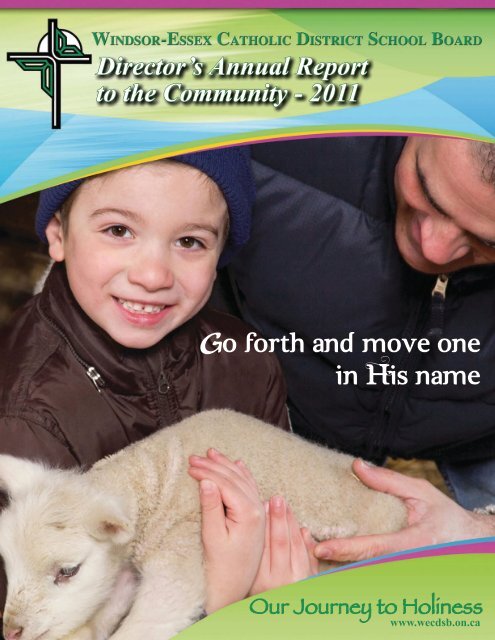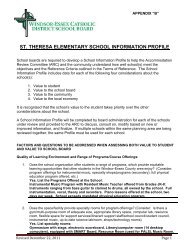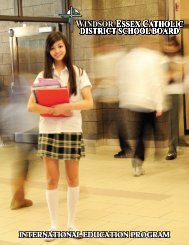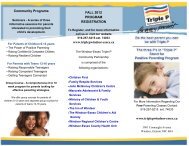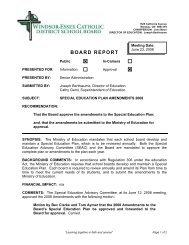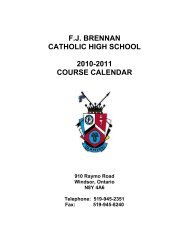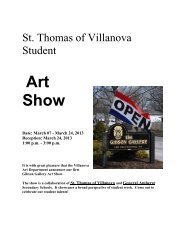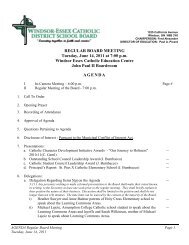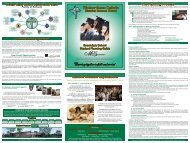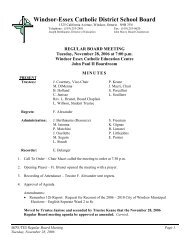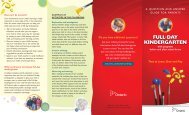2011 Director's Annual Report - Windsor-Essex Catholic District ...
2011 Director's Annual Report - Windsor-Essex Catholic District ...
2011 Director's Annual Report - Windsor-Essex Catholic District ...
- No tags were found...
Create successful ePaper yourself
Turn your PDF publications into a flip-book with our unique Google optimized e-Paper software.
Board Initiatives - <strong>2011</strong>Equity and Inclusive Education StrategyPromoting and supporting equity & inclusion within our <strong>Catholic</strong> community hasbeen a key focal point during the past school year. The Board policy is based onthe Ministry of Education’s Guiding Principles of Equity and Inclusive Education,which states that equity and inclusive education:• is foundational for excellence• meets individual needs• identifies and eliminates barriers• promotes a sense of belonging• involves the broader community• builds on and enhances previous and existing initiatives• is demonstrated throughout the system.Through funding from the Ministry of Education, the Board was able to bringin renowned guest speaker Robert Pio Hajjar to bring forth awareness of thelimitless possibilities that all of our students have within them, particularly thosewith special needs. The event was organized and promoted by our secondaryschool Parent’s Umbrella Group as a Parent Engagement Initiative. Otherprograms designed for the health, safety and well-being of students included theFriends for Life Program, workshops at the Board’s Summer Institute and GettingAlong Digitally internet safety program. Inclusivity took on a new look on ourBoard website with the translation function to multiple languages.The implementation of the policy also included our Board-wide professionaldevelopment day on September 1, where guest speaker Marc Kielburger,addressed all Board employees on the topic of social justice, inclusion and ourresponsibility to help those from other parts of the world who are experiencingdire circumstances and lack of the basic needs. In-servicing was also done as akey component of the Principal and Vice-Principal Mentoring Program in thearea of Human Rights. Other strategies included presentations to our parents atthe School Council Chairperson’s Commissioning Ceremony and for our studentleadership at the annual Student Senate Faith Day Retreat.<strong>Catholic</strong> Character Development – “Getting Along Digitally”“Getting Along Digitally” (GAD) is a peer-led student delivery model designedto capture what youth define as problematic social networking use, and whatcan be effective in reducing these problems. The model was developed andtested with youth from Holy Names <strong>Catholic</strong> Secondary School and beganwith an opportunity to share, candidly among themselves, about their onlineexperiences and provide each other with guidance that takes into accountjust how important (but not exclusive) online activities are to youth. Two mainquestions guided these discussions:How does your online presence reflect on your <strong>Catholic</strong> Character?How does your online presence reflect the person you are and want to be?Secondary students were encouraged, as part of their course curriculumrequirements, to write, perform, and produce both a video and live presentationon a topic of their choice. Older students presented to younger students abouttheir online experiences and provide them with non-judgmental information thattakes into account just how important the ‘Net’ is to their social relationships.The project focussed on ways in which youth communicate with their peersonline. The intent of the program is to enhance and support school-based antibullyingand <strong>Catholic</strong> Character development programs already existing in ourschools.Mentoring For Newly Appointed School Leaders“School leadership matters.” In September of 2008, the <strong>Windsor</strong>-<strong>Essex</strong><strong>Catholic</strong> <strong>District</strong> School Board launched a Ministry funded initiative for newlyappointed Principals and Vice Principals. This two-year program is part ofthe comprehensive Ontario Leadership Strategy designed to support studentachievement by attracting and developing passionate and skilled leaders inSchool Boards across the province. For <strong>2011</strong>, our 14 newly appointedschool leaders were provided with a mentor to advise, challenge4and guide them as they embarked on their career as a <strong>Catholic</strong> school leader.Participants in the program attended a number of sessions throughout the yeardesigned to assist them in their spiritual, personal and professional development.The sessions included: School Improvement, Instructional Leadership, DevelopingStrong Parish/School Relationships, Finance, School Organization, Safe Schools,Staffing, Legal Responsibilities and numerous other topics. Participants in theprogram were provided with the opportunity to attend leadership seminars andto purchase resources and research materials relevant to their new leadershiprole in <strong>Catholic</strong> Schools. The program continues in <strong>2011</strong>-12 with a total of thirtynineparticipants.Ontario English <strong>Catholic</strong> Teachers Association/Ontario <strong>Catholic</strong>School Trustees Association (OECTA/OCSTA)Religious Education CoursesWith the support of Senior Administration, Several Parish Pastors and ourDedicated Teaching Staff, part two of the OECTA/OCSTA Religious Educationcourse was offered this fall. A true community of believers was formed amongthe teachers participating on a weekly basis for four months of learning. Teacherswere instructed on such topics as Sacraments and Liturgy, Sacred Scripture,Morality, and Faith Formation and Learning. Technology has also beenincorporated into the course with an online portion of delivery. Assignmentsencouraged teachers to utilize the Ontario <strong>Catholic</strong> Graduate Expectations and toexplore ways of teaching <strong>Catholic</strong>ity across the curriculum.Parents Reaching Out (PRO) InitiativesOntario Ministry of Education Parents Reaching Out grants are designed toencourage parents to become involved in their children’s education and tosupport student learning at the school. Within the <strong>Windsor</strong>-<strong>Essex</strong> <strong>Catholic</strong><strong>District</strong> School Board, a number of our School Councils submitted proposals andwere successful in receiving up to $1000 to support their parent engagementactivity.Cardinal Carter – Empowering Our Students<strong>Catholic</strong> Central – Community Parent-Engagement EventSt. Anne – Social Networking Websites –The Dangers and How to Connect with your TeenChrist the King – Creating an Equitable and Inclusive CommunitySt. John the Baptist – Growing Parent InvolvementSt. Louis – Parents for Health/Technology and Careers for KidsSt. Mary – Parenting Information EveningParent Involvement Committee (PIC)The <strong>Windsor</strong>-<strong>Essex</strong> <strong>Catholic</strong> <strong>District</strong> School Board, in response to Regulation612/00, introduced a Parent Involvement Committee (PIC) in <strong>2011</strong>. The PIC is animportant advisory body to school boards and actively supports school councilsby enhancing their role in fostering parent engagement, building capacity andsharing information. The PIC is a formal structure and a key vehicle at the boardlevel that enhances parent involvement and supports student achievement,faith formation and well-being. The PIC provides an important link betweenparents and the Board’s Director of Education and Trustees. There are tenparent representatives with three alternate parent representatives, a diocesanrepresentative, a post-secondary representative, and a community-at-largerepresentative; all of whom have voting rights. In addition, there is a Trusteerepresentative and two Director’s representatives; all of whom do not havevoting rights.
Board Initiatives - <strong>2011</strong>We continue to mentorour Full-day EarlyLearning KindergartenTeams to ensure that theeducational experienceswe provide our fourand five year olds areenriching.Full-day Early Learning Kindergarten Program (FDELKP)We are currently offering a Full-day Early Learning Kindergarten Program in11 elementary schools in the <strong>Windsor</strong>-<strong>Essex</strong> <strong>Catholic</strong> <strong>District</strong> School Board.Throughout the course of <strong>2011</strong> we also launched the Extended Day componentof the FDELKP in four schools, establishing third party agreements with theexisting child care providers in those sites. In collaboration with the coterminousBoard and the Municipalities, we have selected sites to be included in the nextthree phases in the implementation of Full-day Early Learning Kindergarten.In some instances it will be necessary to build additions and retrofit space toadequately accommodate four and five year olds in a full-day program for PhaseThree implementation that will take place in September 2012. The preliminaryplanning required to begin this process was initiated.The following <strong>Catholic</strong> elementary schools currently offer Full-day Early LearningKindergarten Programs.• H. J. Lassaline• Our Lady of the Annunciation• Our Lady of Perpetual Help• St. Angela• St. James• St. Louis• W. J. Langlois• St. John the Baptist• St. Bernard• Queen of Peace• St. JohnJumpstart StudentsNutrition ProgramsIn <strong>2011</strong>, twenty-nineelementary and secondaryschools operated Jumpstart Student Nutrition Programs offering nutritious foodsto their students three to five days per week. In most instances, nutritious snackswere offered, primarily fruits and vegetables. In some instances breakfast wasprepared for students. Many schools also provide nutritious foods to studentsthrough an Emergency Food CupBoard.These programs continue to be funded through the Ontario Student NutritionProgram, Pathway to Potential, Breakfast for Learning, Breakfast Clubs ofCanada as well as numerous fundraising opportunities sponsored by theJumpstart Community Partnership Committee and individual schools. Througha generous fund established through the Do Good Divas, Student NutritionPrograms continue to provide equipment and appliances. We would also like toacknowledge the generous support of the Teacher’s Have Heart organization, theemployees of Hotel Dieu-Grace Hospital, the <strong>Windsor</strong> Lawyers’ Association aswell as the CARE Committee of the <strong>Windsor</strong>-<strong>Essex</strong> <strong>Catholic</strong> <strong>District</strong> School Board.The Board also choseto implement a FulldayKindergartenProgram at St.John the Evangelist<strong>Catholic</strong> ElementarySchool in the <strong>2011</strong>-2012 school year.This implementationstrategy includedseveral ParentInformationmeetings, which were hosted by schools that would be launching new Full-dayEarly Learning Kindergarten Programs in their schools in September <strong>2011</strong>. Thesesessions were well attended and provided an excellent venue for our Boardlead, principals and teachers to answer questions or concerns that parents hadregarding the Full-day Early Learning Kindergarten Program.5
Board Initiatives - <strong>2011</strong>Environment – Green Update!The following are some environmental-friendly projects that took place in our<strong>Catholic</strong> elementary and secondary schools…Students in the Cardinal Carter greenhouse planted native plant seeds for habitatrestoration at the park.Students from Assumption College designed, constructed and planted acommunity garden. They watered and weeded the garden throughout the summermonths and harvested the crops as they matured.St. Anne French Immersion School organized a highly successful planting day onSaturday, May 28, <strong>2011</strong>. The Pepsi Refresh Challenge money was put to good useas 103 plants, trees and shrubs were planted to help beautify the school grounds.6
Highest, Lowest and Provincial Average English-Language Board Level69% 68% 70% 71% 69%60%EQAO Assessment – Grades 3 and 6:50%50% 51%52%46% 48%Provincial English-Language 40%Board Level ResultsHighest, Highest, Results based Lowest on and and Percentage Provincial Provincial of Average Students Average English-Language at Levels English-Language 3 and above, Board 2006- Level Board Level Results based on Percentage of Students atHighest Provincial Average LowestLevels Results 3 and based above, on Percentage 2006-20072007 of to Students 2010-<strong>2011</strong>to 2010-<strong>2011</strong> at Levels 3 and above, 2006-2007 to 2010-<strong>2011</strong>Grade 3 Reading 2006-2007 2007-2008 2008-2009 2009-2010 2010-<strong>2011</strong>Highest 73% 73% 75% 75% 77%Grade 3 Reading 2006-2007 2007-2008 2008-2009 2009-2010 2010-<strong>2011</strong>HighestProvincial Average 62%73%61%73%61%75%62%75%65%77%LowestProvincial Average45%62%49%61%41%61%41%62%46%65%Lowest 45% 49% 41% 41% 46%80%70%30%20%81% 80%84% 83% 83%2006-2007 2007-2008 2008-2009 2009-2010 2010-<strong>2011</strong>Grade 6 Reading 2006-2007 2007-2008 2008-2009 2009-2010 2010-<strong>2011</strong>Highest 74% 77% 79% 82% 85%Provincial Average 64% 66% 69% 72% 74%Lowest 54% 53% 53% 55% 58%100%100%90%90%80%80%70%70%60%60%50%50%40%40%30%30%20%20%Highest, Lowest and Provincial Average Score in EQAO Grade 3 Reading, from2006-2007 to 2010-<strong>2011</strong>Highest, Lowest and Provincial Average Score in EQAO Grade 3 Reading, from2006-2007 to 2010-<strong>2011</strong>73% 73% 75% 75%73% 73% 75% 75%62% 61% 61% 62%62% 61% 61% 62%49%45%49%41% 41%45%41% 41%77%77%65%65%46%46%2006-2007 2007-2008 2008-2009 2009-2010 2010-<strong>2011</strong>2006-2007 2007-2008 2008-2009 2009-2010 2010-<strong>2011</strong>Highest Provincial Average LowestHighest Provincial Average Lowest100%90%80%70%60%50%40%30%20%Highest, Lowest and Provincial Average Score in EQAO Grade 6 Reading, from2006-2007 to 2010-<strong>2011</strong>74%77%64% 66%54%79%69%82%53% 53% 55%85%72% 74%2006-2007 2007-2008 2008-2009 2009-2010 2010-<strong>2011</strong>Highest Provincial Average Lowest58%Grade Writing 2006-2007 2007-2008 2008-2009 2009-2010 2010-<strong>2011</strong>Grade 3 Writing 2006-2007 2007-2008 2008-2009 2009-2010 2010-<strong>2011</strong>Highest 79% 79% 82% 85% 89%Highest 79% 79% 82% 85% 89%Provincial Average 64% 66% 68% 70% 73%Provincial Average 64% 66% 68% 70% 73%LowestLowest46%46%44%44%40%40%44%44%46%46%Highest,Highest,LowestLowestandandProvincialProvincialAverageAverageScoreScoreininEQAOEQAOGradeGrade 3Writing,Writing,fromfrom2006-2007 to 2010-<strong>2011</strong>100%90%89%80%85%82%79% 79%70%73%70%68%60%64% 66%50%40%46% 44%44%46%40%30%20%2006-20072006-20072007-20082007-20082008-20092008-20092009-20102009-20102010-<strong>2011</strong>2010-<strong>2011</strong>Highest Provincial Average LowestHighest Provincial Average LowestGrade 6 Writing 2006-2007 2007-2008 2008-2009 2009-2010 2010-<strong>2011</strong>Highest 74% 79% 78% 83% 84%Provincial Grade 6 Writing Average 2006-2007 61% 2007-2008 67% 2008-2009 67% 2009-2010 70% 2010-<strong>2011</strong> 73%Lowest Highest 49% 74% 52% 79% 50% 78% 46% 83% 55% 84%Provincial Average 61% 67% 67% 70% 73%Lowest 49% 52% 50% 46% 55%100%EQAO_Eng_2010-11.xls 100% 90%| English80% 90%70% 80%60% 70%50% 60%40% 50%30%40%30%20%20%Highest, Lowest and Provincial Average Score in EQAO Grade 6 Writing from2006-2007 to 2010-<strong>2011</strong>Highest, Lowest and Provincial Average Score in EQAO Grade 6 Writing from2006-2007 to 2010-<strong>2011</strong>74%74%61%61%49%49%79% 78%79%67% 78% 67%67% 67%52% 50%52% 50%83% 84%83%70%84% 73%70%73%55%2006-2007 2007-2008 2008-2009 2009-2010 2010-<strong>2011</strong>2006-2007 2007-2008 2008-2009 2009-2010 2010-<strong>2011</strong>Highest Provincial Average Lowest46%46%Highest Provincial Average Lowest55%Grade 6 Math 2006-2007 2007-2008 2008-2009 2009-2010 2010-<strong>2011</strong>Grade 3 Math 2006-2007 2007-2008 2008-2009 2009-2010 2010-<strong>2011</strong> Highest Grade 6 Math 2006-2007 71% 2007-2008 76% 2008-2009 76% 2009-2010 76% 2010-<strong>2011</strong> 76%Highest 81% 80% 84% 83% 83% Provincial Highest Average 59% 71% 61% 76% 63% 76% 61% 76% 58% 76%Provincial Average 69% 68% 70% 71% 69% Lowest Provincial Average 46% 59% 41% 61% 47% 63% 43% 61% 38% 58%Lowest 50% 51% 46% 48% 52% Lowest 46% 41% 47% 43% 38%EQAO_Eng_2010-11.xls | English Page 1 of 5EQAO_Eng_2010-11.xls English Page of Highest, Lowest and Provincial Average Score in EQAO Grade 6 Math, from 2006-2007Highest, Lowest and Provincial Average Score in EQAO Grade 3 Math, from 2006-2007Highest, Lowest and Provincial Averageto 2010-<strong>2011</strong>Score in EQAO Grade 6 Math, from 2006-2007to 2010-<strong>2011</strong>to 2010-<strong>2011</strong>100%90%80%70%60%50%40%81% 80%84% 83% 83%69% 68% 70% 71% 69%50% 51%52%46% 48%100%100%90%90%80%80%70%60%50%40%30%76% 76% 76% 76%71%63% 59% 61%61%58%46%47%41%43%38%30%20%20%10%2006-2007 2007-2008 2008-2009 2009-2010 2010-<strong>2011</strong>Highest Provincial Average Lowest0%2006-2007 2007-2008 2008-2009 2009-2010 2010-<strong>2011</strong>Highest Provincial Average LowestGrade 6 Reading 2006-2007 2007-2008 2008-2009 2009-2010 2010-<strong>2011</strong>Highest 74% 77% 79% 82% 85%Provincial Average 64% 66% 69% 72% 74%Lowest 54% 53% 53% 55% 58%7
67 66 67 68 67 70 65 61 61 78 81 75 77 77 73 76 69 69 60 EQAO Assessment – Grade 3: <strong>Windsor</strong>-<strong>Essex</strong> 40 <strong>Catholic</strong> <strong>District</strong> School Board20 and Provincial Results0 % of students achieving Level 3/4 100 80 WECDSB Primary (Gr.3) EQAO -‐ Historical Results Primary Reading Primary Wri8ng Primary Math 2005-‐2006 2006-‐2007 2007-‐2008 2008-‐2009 2009-‐2010 2010-‐<strong>2011</strong> % of students achieving Level 3/4 100 80 60 40 20 0 WECDSB Primary (Gr.3) EQAO -‐ Historical Results 78 81 75 77 77 67 66 67 68 67 70 73 76 69 65 61 61 Primary Reading Primary Wri8ng Primary Math 69 2005-‐2006 2006-‐2007 2007-‐2008 2008-‐2009 2009-‐2010 2010-‐<strong>2011</strong> % of % students of students achieving achieving Level Level 3/4 3/4 100 100 80 80 60 60 40 40 20 20 0 0 WECDSBProvince Primary Primary (Gr.3) (Gr.3) EQAO EQAO -‐ Detailed -‐ Historical Results Results for Males79 81 77 76 76 69 68 69 62 62 61 64 64 66 68 70 7368 69 62 62 61 68 70 71 69 61 62 65 62 61 63 57 59 62 57 Primary Reading Primary Wri8ng Primary Math Primary Reading Primary Wri8ng Primary Math 2005-‐2006 2005-‐2006 2006-‐2007 2006-‐2007 2007-‐2008 2007-‐2008 2008-‐2009 2008-‐2009 2009-‐2010 2009-‐2010 2010-‐<strong>2011</strong> 2010-‐<strong>2011</strong> % of students achieving Level 3/4 100 100 3/4 80 80 60 60 40 40 20 20 0 0 WECDSB Province Primary Primary (Gr.3) (Gr.3) EQAO EQAO -‐ Detailed -‐ Historical Results Results for Males 68 69 62 62 61 64 64 66 68 70 73 79 81 77 68 7076 71 76 61 62 65 69 68 69 62 62 61 62 61 63 57 59 62 57 PrimaryPrimary Reading ReadingPrimaryPrimary Wri8ng Wri8ngPrimaryPrimaryMathMath2005-‐2006 2006-‐2007 2007-‐2008 2008-‐2009 2009-‐2010 2010-‐<strong>2011</strong> % % of of students achieving Level Level 3/4 3/4 100 100 80 80 60 60 40 40 20 20 0 0 WECDSB Primary (Gr.3) EQAO -‐ Detailed Results for Females Province Primary (Gr.3) EQAO -‐ Detailed Results for Males 81 81 76 76 77 77 72 71 73 76 79 78 78 75 69 65 65 68 69 68 67 69 71 57 56 55 56 58 56 56 59 61 64 67 68 60 Primary Reading Primary Wri8ng Primary Math Primary Reading Primary Wri8ng Primary Math 2005-‐2006 2005-‐2006 2006-‐2007 2006-‐2007 2007-‐2008 2007-‐2008 2008-‐2009 2008-‐2009 2009-‐2010 2009-‐2010 2010-‐<strong>2011</strong> 2010-‐<strong>2011</strong> % of students % of students achieving achieving Level Level 3/4 3/4 % of students % of students achieving achieving Level Level 3/4 3/4 100 100 80 80 60 60 40 40 20 200 0 100 100 80 80 60 40 60 20 40 0 20 0 WECDSB Primary (Gr.3) EQAO -‐ Detailed Results for Females Province Primary (Gr.3) EQAO -‐ Detailed Results for Males 81 81 79 76 76 77 77 78 76 78 75 72 73 71 69 68 65 65 69 68 67 69 71 57 56 55 56 58 56 56 59 61 64 67 68 60 Primary Reading Primary Wri8ng Primary Math Primary Reading Primary Wri8ng Primary Math Province Primary (Gr.3) EQAO -‐ Detailed Results for Females WECDSB Primary (Gr.3) EQAO -‐ Detailed Results for Students with Special Needs 72 73 74 75 77 80 68 68 68 68 69 69 72 71 65 67 70 69 47 44 44 38 36 38 33 32 31 19 20 22 25 19 19 19 15 14 Primary Reading Primary Wri8ng Primary Math Primary Reading Primary Wri8ng Primary Math 2005-‐2006 2005-‐2006 2006-‐2007 2006-‐2007 2007-‐2008 2007-‐2008 2008-‐2009 2008-‐2009 2009-‐2010 2009-‐2010 2010-‐<strong>2011</strong> 2010-‐<strong>2011</strong> 2005-‐2006 2006-‐2007 2005-‐2006 2007-‐2008 2006-‐2007 2008-‐2009 2007-‐2008 2009-‐2010 2008-‐2009 2010-‐<strong>2011</strong> 2009-‐2010 2010-‐<strong>2011</strong> % % of of students achieving Level 3/4 3/4 % % of of students achieving Level 3/4 3/4 100 100 80 80 60 60 40 40 20 20 0 100 100 80 80 60 60 40 40 20 20 0 WECDSB Province Primary Primary (Gr.3) (Gr.3) EQAO -‐ EQAO Detailed -‐ Results Detailed for Students Results with for Special Females Needs 72 73 74 75 77 80 68 68 68 68 69 69 72 71 65 67 70 69 47 44 44 38 36 38 33 32 31 19 20 22 25 19 19 19 15 14 Primary Reading Primary Wri8ng Primary Math Primary Reading Primary Wri8ng Primary Math ProvinceWECDSB Primary (Gr.3) EQAO Primary (Gr.3) EQAO -‐ -‐ Detailed Results for English Language Learners Detailed Results for Students with Special Needs 68 57 47 50 53 53 54 50 42 45 41 48 43 35 35 37 40 38 35 35 36 37 31 34 21 22 25 27 27 30 26 24 19 15 19 20 Primary Reading Primary Wri8ng Primary Math Primary Reading Primary Wri8ng Primary Math 2005-‐2006 2005-‐2006 2006-‐2007 2006-‐2007 2007-‐2008 2007-‐2008 2008-‐2009 2008-‐2009 2009-‐2010 2009-‐2010 2010-‐<strong>2011</strong> 2010-‐<strong>2011</strong> 2005-‐2006 2005-‐2006 2006-‐2007 2006-‐2007 2007-‐2008 2007-‐2008 2008-‐2009 2008-‐2009 2009-‐2010 2009-‐2010 2010-‐<strong>2011</strong> 2010-‐<strong>2011</strong> % % of of students achieving Level 3/4 3/4 100 100 80 80 60 60 40 40 20 20 0 0 ProvinceWECDSB Primary (Gr.3) EQAO Primary (Gr.3) EQAO -‐ -‐ Detailed Results for English Language Learners Detailed Results for Students with Special Needs 68 57 47 50 53 53 54 50 42 45 41 48 43 35 35 38 37 40 35 35 36 37 31 34 21 22 25 27 27 30 26 24 19 15 19 20 Primary Reading Primary Wri8ng Primary Math Primary Reading Primary Wri8ng Primary Math 2005-‐2006 2005-‐2006 2006-‐2007 2006-‐2007 2007-‐2008 2007-‐2008 2008-‐2009 2008-‐2009 2009-‐2010 2009-‐2010 2010-‐<strong>2011</strong> 2010-‐<strong>2011</strong> % of students achieving Level 3/4 100 80 60 40 20 0 Province Primary (Gr.3) EQAO -‐ Detailed Results for English Language Learners 64 66 58 60 62 62 51 54 53 56 58 60 54 42 44 45 46 46 Primary Reading Primary Wri8ng Primary Math 2005-‐2006 2006-‐2007 2007-‐2008 2008-‐2009 2009-‐2010 2010-‐<strong>2011</strong> % of students achieving Level 3/4 100 80 60 40 20 0 Province Primary (Gr.3) EQAO -‐ Detailed Results for English Language Learners 64 66 58 60 62 62 51 54 53 56 58 60 54 42 44 45 46 46 Primary Reading Primary Wri8ng Primary Math 2005-‐2006 2006-‐2007 2007-‐2008 2008-‐2009 2009-‐2010 2010-‐<strong>2011</strong> 8
Innovative Programs to Support Success for all Students K-12School Effectiveness Framework (SEF):Principals and teachers continue to focus onevidence-based strategies in both Literacy andNumeracy. Two areas of focus from the frameworkinclude, “Curriculum, Teaching and Learning”and “Assessment for, as and of Learning”. SMARTgoals were developed and aligned with the BoardImprovement Plan. Developing Learning Goalsand Success Criteria in the areas of critical literacywere introduced to our teachers and principals.Schools Helping SchoolsThroughout the school year, some schools wereinvolved in “Professional Learning Communities”.Teachers participated in moderated marking,working collaboratively with other colleagueson consistency in assessment and evaluation ofleveling student work. Other activities includejob-embedded professional learning as well as coplanning,co-teaching and co-debriefingwith Board support personnel. Studentswere also engaged in “critical thinkingskills” and rich tasks.A display of student work from our Cycles ofInstruction – Literacy sessions.Schools in the MiddleThe Ministry of Education identified “Schoolsin the Middle” through Education QualityAccountability Office (EQAO) and assessmentresults over time. Schools that were achievingin the Level Two range participated in a“Collaborative Inquiry”, which includeda focus on Literacy or Numeracy.Through the collaborative inquiry, schoolteams reflected on student learningthat involved effective questioning,assessment and evaluation and feedback.Student Learning ScansThroughout the past year, twelveschool communities were engaged in “Student Learning Scans” conducted by theSuperintendents, SEF Lead Principals and Vice-Principals. The format designedthrough the implementation of the scans allowed for the opportunity to dialoguewith teachers regarding students’ strengths, weaknesses and instructionalpractices. The scan also afforded us the opportunity to engage students indiscussion regarding their own learning and to celebrate the tremendous growth inevidence-based strategies.iPod Project via Schools in the MiddleStudents have been incorporating the iPods intheir writing process to help with peer revision.Priority SchoolsThroughout our system, schools have beendesignated as priority schools requiring additionalsupport and attention. The designation is assigned after scrutiny of EQAO data,PM Benchmark data, Comprehensive Assessment Survey Instrument (CASI) data,Ontario Focused Intervention Partnership (OFIP) designation as well as SchoolImprovement Plans. Board Strategy Team (BST) members and Consultants workcollaboratively with Principals to design effective professional learning communitymeetings focused on evidence-based classroom strategies, effective assessmentand evaluation practice, as well as other capacity-building activities.Activities that support these strategies may include job-embedded professionallearning as well as co-planning, co-teaching and co-debriefingthrough accessing Board support.10Student Work Study InitiativeThe purpose of the School Work Study Initiative (SWSI) is to learn about:a. The characteristics of student workfrom Level One through Level Twoand into Level Three.b. The type of feedback to students thatresults in improved work.c. The type of tasks and prompts thatresult in students improving theirlearning towards the provincialstandard.d. How students who are achievingLevel Two work and think in reading,writing and math.The Student Work Study Teacher (SWST) collaborateswith the classroom teacher to share observationsof how students approach their work, determinethe learning needs of the students and providespecific feedback and coaching to students in orderto improve their work. It is a co-learning modelwhereby the teachers learn from the student work.S.T.A.R. Tutoring Program (StudentTutoring Achieving Results)Our partnership with the <strong>Windsor</strong>-<strong>Essex</strong> Chapterof the Learning Disabilities of Ontario continued throughout <strong>2011</strong>. As a result,we have hosted tutoring programs for students in Grade 4, 5 and 6 in schoolsthroughout our Board. Students attended two-hour sessions, two nightsper week, in two different locations throughout <strong>Windsor</strong> and <strong>Essex</strong> County.There was also an Adaptive Technology Facilitator at each site, who workedwith teachers and students to provide direct instruction on how to effectivelyintegrate adaptive software in a learning environment.The Learning Disabilities Association of Ontario (LDAO) also designed a programfor students with learning disabilities in conjunction with the Focus on YouthProgram. This initiative focused on literacy and incorporated the use of
Innovative Programs to Support Success for all Students K-12what is available within our community. A second system-wide webcast was heldon November 18, <strong>2011</strong> that included a panel of six experts from the Board andthe Community Health Providers in the area of student mental health.Collaborative Inquiry Learning in Math – CIL-M:Sixteen teachers and four principals/vice-principals from four schools areinvolved in a new Ministry initiative with Board support in learning about Maththrough a “lesson study” format. The Math Curriculum and Big Ideas associatedwith the three-part Math lesson, problem solving, student work and studentvoice are the key features in this numeracy initiative. Teachers co-plan, co-teachand co-debrief while networking with other colleagues.French Immersion ProgramThe French Immersion Program in both elementary and secondary schoolscontinues to grow. St. Mary <strong>Catholic</strong> Elementary School in Maidstone offers fullday,every-day French Immersion classes from Junior Kindergarten to Grade 6 thisyear. St. Anne Elementary School, in the Walkerville area continues to flourish.St. Thomas of Villanova, Cardinal Carter, St. Anne and St. Joseph’s SecondaryFrench Immersion students continue to work closely with our two elementaryFrench Immersion schools. Our French Immersion students have participated inmany activities showcasing our French heritage.NTIP – New Teacher Induction ProgramThe New Teacher Induction Program supports new elementary and secondaryteachers in their professional learning. Participants benefit from professionaldevelopment opportunities in the areas of Classroom Organizational Strategies,Mentoring, Assessment and Evaluation, Safe Schools, and Special Education. Aspart of our differentiated approach to professional development, new teachers areable to participate in a session of their choice, such as Effective Practices for Frenchas a Second Language (FSL), Differentiated Instruction, Kindergarten, EffectiveLiteracy and Numeracy Blocks, and Using Technology. <strong>Catholic</strong>ity is an importantfacet of each session. Participants also receive professional resources and havechosen a mentor who will be available to offer practical support throughout theprogram.Reading, 71% Writing, and 59% in Mathematics. Our Grade 6 students exceededthe provincial level of achievement in the area of Mathematics.Key Board/school strategies implemented during the 2010-<strong>2011</strong> school yearto support reading and writing instructionincluded:• Professional Learning Community (PLC)meetings, which focused on student work,teacher moderation and instructionalstrategies.• Implementation of Cycles of Instruction toengage teachers in higher order thinkingstrategies such as making connections,making inferences and point of view.• Board Strategy Team supporting teachersand students in the analysis of dataand implementation of evidence-basedstrategies through job embeddedprofessional development.• Implementation of Collaborative Inquiryin collaboration with the Schools in theMiddle Ministry initiative and support from the Literacy Numeracy Secretariat.• Developing the capacity of educational leadership.Early Primary Collaborative InquiryOur Early Primary Collaborative Inquiry was a continuation of the inquiry webegan in the 2009-2010 school year. The seven teachers involved the previousyear were able to work with additional teachers from their school sites to providesupport and the ‘voice of experience.’ Collaboration was facilitated by the useof various types of groupings; at times the teachers met in school-based groups,and at other times in Grade-level groups.In our inquiry, we continued to focus on the development of high-levelvocabulary related to the themes of Belonging, Kindness, and Goodness, and weadded the theme of Gratitude. Many of the students were involved for a secondyear, therefore we also developed additional sets of literature-based lessons.We continued to follow the model demonstrated in the Literacy NumeracySecretarial (LNS) Webcast, Kindergarten Matters: Planned, Purposeful andPlayful Talk. The read-aloud lessons were designed to be completed within theliteracy block (Grade 1 and 2) or during the read-aloud learning opportunitiesincorporated into the Kindergarten program.Education Quality Accountability Office (EQAO)Grade 3 & 6 – Literacy/Numeracy:Reading, Writing and Mathematics, Primary Division (Grades 1-3)In our Grade 3 cohort 65% of our students achieved a level three or level four inthe area of Primary Reading, 73% in Writing and 69% in Mathematics. In all areasof Reading, Writing and Math, Grade 3 students met the provincial achievementlevel.Reading, Writing and Mathematics, Junior Division (Grades 4-6)In our Grade 6 cohort 72% of our students achieved a level three or level four in13
WINDSOR-ESSEXCATHOLICDISTRICT SCHOOL BOARDWECDSB Model ofGRADES 1-3GRADES 4-6GRADES 7-8Diagnostic Assessment Information:CBMPM Benchmark<strong>Report</strong> CardTeacher observations,checklists, etc.Diagnostic Assessment Information:CBMPM Benchmark, CASI<strong>Report</strong> CardGrade 3 EQAOTeacher observations,checklists, etc.Diagnostic Assessment Information:CASI<strong>Report</strong> CardGrade 3 & 6 EQAOTeacher observations,checklists, etc.Written/oral performance tasksIs thestudent meetinggradeexpectations?If YesIs thestudent meetinggradeexpectations?If YesIs thestudent meetinggradeexpectations?If YesSTEP1If No If No If NoSTEPSTEP11Meet with School Based TeamMeet with School Based TeamMeet with School Based TeamWhatis neededfor studentsuccess?Whatis neededfor studentsuccess?Whatis neededfor studentsuccess?Accommodations:Ontario Curriculum expectationsare not alteredAccommodations:Ontario Curriculum expectationsare not alteredAccommodations:Ontario Curriculum expectationsare not alteredFurther Professional Intervention:Mental Health & Well-BeingSocial WorkerBehaviour TeamPsychologyCommunity SupportsSpeech/Language PathologistsFurther Professional Intervention:Mental Health & Well-BeingSocial WorkerBehaviour TeamPsychologyCommunity SupportsSpeech/Language PathologistsFurther Professional Intervention:Mental Health & Well-BeingSocial WorkerBehaviour TeamPsychologyCommunity SupportsSpeech/Language PathologistsModifications:Modification of OntarioCurriculum expectationsSTEP2Modifications:Modification of OntarioCurriculum expectationsSTEP2Modifications:Modification of OntarioCurriculum expectationsSTEP2Cross Panel Meeting with High School:Pathway discussionStudent voiceParent voice
Diagnostic Decision MakingGRADES 9-10GRADES 11-12CBM:Curriculum BasedMeasurement:A set of tools thatmeasure proficiencyof reading-relatedskills (decoding,fluency andcomprehension)PM Benchmark:Assessment ofReading (Decoding,Comprehensionand Fluency)CASI:Comprehension,Attitude, Strategies,Interest (Assessmentof ReadingComprehension)EQAO:Education Quality &Accountability Office(Assessment ofGrades 3 & 6Reading, Writing,Mathematics;Grade 9 Mathematics)OSSLT:Ontario SecondarySchool Literacy Test(Assessment ofReading & Writing)Diagnostic Assessment Information:CASI<strong>Report</strong> CardGrade 3, 6 & 9 EQAOGrade 9 Literacy AssessmentTeacher observations,checklists, etc.Is thestudent meetinggradeexpectations?If NoMeet withCommittee At-Risk TeamWhatis neededfor studentsuccess?Accommodations:Ontario Curriculum expectationsare not alteredFurther Professional Intervention:Mental Health & Well-BeingSocial WorkerBehaviour TeamHomework HelpPathway Review:Pathway discussionStudent VoiceIf YesDiagnostic Assessment Information:<strong>Report</strong> CardGrade 3, 6 & 9 EQAOGrade 9 Literacy AssessmentOSSLTTeacher observations,checklists, etc.Is thestudent on theappropriatepathway?If NoMeet withCommittee At-Risk TeamWhatis neededfor studentsuccess?Pathway Review:Pathway discussionStudent VoiceParent VoiceFurther Professional Intervention:Mental Health & Well-BeingSocial WorkerBehaviour TeamHomework HelpAlternative ProgrammingCooperative EducationContinuing EducationIf YesUNIVERSITY COLLEGE APPRENTICESHIP WORKPLACESchool College Work InitiativeOctober, <strong>2011</strong>
50%EQAO Assessment Grade 9 and 10:40%Provincial English-Language Board Level30%Results 32%Highest, Lowest and Provincial Average English-Language Board Level Results based on Highest Percentage Provincial of Average Students Lowest atLevels 3 and above, 2006-2007 to 2010-<strong>2011</strong>Grade 9 AcademicMath2006-2007 2007-2008 2008-2009 2009-2010 2010-<strong>2011</strong>Highest 83% 88% 86% 90% 92%Provincial Average 71% 75% 77% 82% 83%Lowest 32% 50% 31% 53% 60%70%60%20%71%75% 77%50%Grade 9Applied Math2006-2007 2007-2008 2008-2009 2009-2010 2010-<strong>2011</strong>Highest 64% 53% 67% 63% 60%Provincial Average 35% 34% 38% 40% 42%Lowest 7% 15% 23% 25% 30%31%2006-2007 2007-2008 2008-2009 2009-2010 2010-<strong>2011</strong>82%53%60%Highest, Lowest and Provincial Average Score in EQAO Grade 9 Academic Math, from2006-2007 to 2010-<strong>2011</strong>Highest, Lowest and Provincial Average Score in EQAO Grade 9 Applied Math, from2006-2007 to 2010-<strong>2011</strong>100%80%90%80%70%60%50%40%30%20%90% 92%88% 86%83%82% 83%75% 77%71%60%50%53%32%31%2006-2007 2007-2008 2008-2009 2009-2010 2010-<strong>2011</strong>70%60%50%40%30%20%10%0%67%64%63%60%53%40%42%38%35% 34%23%25%30%15%7%2006-2007 2007-2008 2008-2009 2009-2010 2010-<strong>2011</strong>Highest Provincial Average LowestHighest Provincial Average LowestGrade 9Applied Math2006-2007 2007-2008 2008-2009 2009-2010 2010-<strong>2011</strong>Highest 64% 53% 67% 63% 60%Provincial Average 35% 34% 38% 40% 42%Lowest 7% 15% 23% 25% 30%80%70%60%50%40%30%20%10%0%Highest, Lowest and Provincial Average Score in EQAO Grade 9 Applied Math, from2006-2007 to 2010-<strong>2011</strong>64%53%35% 34%7%15%Source: Data for Grades 3, 6 and 9 is sourced from the Education Quality and Accountability Office(EQAO) and is based on suppressed data.* Percentages are represented as a percent of all students (method 1) within the context as per EQAOwith suppression rules applied.67%38%23%2006-2007 2007-2008 2008-2009 2009-2010 2010-<strong>2011</strong>63%40%25%Highest Provincial Average Lowest60%42%30%Source: Data for Grades 3, 6 and 9 is sourced from the Education Quality and Accountability Office(EQAO) and is based on suppressed data.* Percentages are represented as a percent of all students (method 1) within the context as per EQAOwith suppression rules applied.This report has been provided for the purpose of updating Directors' <strong>Annual</strong> <strong>Report</strong>s.EQAO_Eng_2010-11.xls | EnglishHighest, Lowest and Provincial Average English-LanguageBoard Level Results based on Percentage of Students thatOSSLT, 2006-2007 to 2010-<strong>2011</strong>Successfully Passed the OSSLT, 2006-2007 to 2010-<strong>2011</strong>Highest, Lowest and Provincial Average English-Language Board LevelResults based on Percentage of Students that Successfully Passed theGrade 10 OSSLT(First-Time Eligible)2006-2007 2007-2008 2008-2009 2009-2010 2010-<strong>2011</strong>Highest 91% 92% 92% 92% 91%Provincial Average 84% 84% 85% 84% 83%Lowest 73% 75% 72% 69% 72%Highest, Lowest and Provincial Average Score in EQAO Grade 10 OSSLT, from2006-2007 to 2010-<strong>2011</strong>This report has been provided for the purpose of updating Directors' <strong>Annual</strong> <strong>Report</strong>s.100%90%91% 92%EQAO_Eng_2010-11.xls | English 80% Page 4 of 5 84% 84%70%73%75%60%92% 92% 91%85%84% 83%72%69%72%50%40%30%2006-2007 2007-2008 2008-2009 2009-2010 2010-<strong>2011</strong>Highest Provincial Average LowestSource: Data for Grade 10 OSSLT is sourced from the Education Quality and Accountability Office(EQAO) and is based on suppressed data.16* Percentages are represented as a percent of all participating students (method 2) within the contextas per EQAO with suppression rules applied.This report has been provided for the purpose of updating Directors' <strong>Annual</strong> <strong>Report</strong>s.
% of students achieving Le86 71 72 73 77 80 2005-‐2006 80 2006-‐2007 60 47 2007-‐2008 42 44 38 37 36 40 EQAO Assessment – Grade 9: <strong>Windsor</strong>-<strong>Essex</strong> 20 <strong>Catholic</strong> <strong>District</strong> School Board0 Academic Applied and Provincial Results2008-‐2009 2009-‐2010 2010-‐<strong>2011</strong> % of students achieving Level 3/4 100 80 60 40 20 0 WECDSB Gr.9 EQAO MathemaEcs -‐ Historical Results 86 71 72 73 77 80 47 42 44 38 37 36 Academic Applied 2005-‐2006 2006-‐2007 2007-‐2008 2008-‐2009 2009-‐2010 2010-‐<strong>2011</strong> % of students achieving Level 3/4 % of students achieving Level 3/4 100 100 80 80 60 60 40 40 20 20 0 0 WECDSBProvince Gr.9 EQAOGr.9 EQAO MathemaEcs MathemaEcs -‐ Detailed -‐ Historical Results Results for Males76 76 86 80 74 82 81 83 75 77 71 71 44 41 39 47 50 36 42 38 40 35 35 34 Academic Academic Applied Applied 2005-‐2006 2006-‐2007 2005-‐2006 2007-‐2008 2006-‐2007 2008-‐2009 2007-‐2008 2009-‐2010 2008-‐2009 2010-‐<strong>2011</strong> 2009-‐2010 2010-‐<strong>2011</strong> % of students achieving Level 3/4 % of students achieving Level 3/4 % of students achieving Level 3/4 % of students achieving Level 3/4 100 80 60 100 4080 2060 040 20 0 100 80100 60 80 40 60 20 40 0 20 0 WECDSB Gr.9 EQAO MathemaEcs -‐ Detailed Results for Males Province Gr.9 EQAO MathemaEcs -‐ Historical Results 76 76 80 74 86 81 44 47 50 71 71 75 77 82 83 41 39 36 35 35 34 38 40 42 Academic Applied Academic Applied WECDSB Province Gr.9 Gr.9 EQAO EQAO MathemaEcs MathemaEcs -‐ Detailed -‐ Detailed Results Results for for Females Males 86 68 68 71 74 79 72 72 77 80 83 84 47 39 35 35 36 39 37 37 36 41 44 44 Academic Applied Academic Applied 2005-‐2006 2006-‐2007 2007-‐2008 2008-‐2009 2005-‐2006 2009-‐2010 2006-‐2007 2007-‐2008 2010-‐<strong>2011</strong> 2008-‐2009 2009-‐2010 2010-‐<strong>2011</strong> 2005-‐2006 2005-‐2006 2006-‐2007 2006-‐2007 2007-‐2008 2007-‐2008 2008-‐2009 2008-‐2009 2009-‐2010 2009-‐2010 2010-‐<strong>2011</strong> 2010-‐<strong>2011</strong> % of students achieving Level 3/4 % of students achieving Level 3/4 % of students achieving Level 3/4 100 80 % of students achieving Level 3/4 100 100 80 80 60 60 40 40 20 20 0 0 60 100 40 80 20 60 40 0 20 0 WECDSB Province Gr.9 Gr.9 EQAO EQAO MathemaEcs -‐ Detailed -‐ Detailed Results Results for for Females Males 68 72 68 72 34 70 69 71 77 74 80 Academic 74 75 Academic 86 83 81 79 84 82 39 37 33 353733 35 36 36 41 Applied WECDSB Gr.9 EQAO MathemaEcs -‐ Detailed Results for Students with Special Needs Province Gr.9 EQAO MathemaEcs -‐ Detailed Results for Females 64 72 67 Academic 76 74 44 28 37 31 32 Applied 34 Applied 47 44 39 36 44 39 35 39 2005-‐2006 2005-‐2006 2006-‐20072006-‐20072007-‐20082007-‐20082008-‐20092008-‐20092009-‐2010 2009-‐2010 2010-‐<strong>2011</strong> 2010-‐<strong>2011</strong> 2005-‐2006 2006-‐2007 2005-‐2006 2007-‐2008 2006-‐2007 2008-‐2009 2007-‐2008 2009-‐20102008-‐20092010-‐<strong>2011</strong>2009-‐20102010-‐<strong>2011</strong> % of students achieving Level 3/4 % of students achieving Level 3/4 100 80 100 80 60 60 40 40 20 20 0 0 Province Gr.9 EQAO MathemaEcs -‐ Detailed Results for Females WECDSB Gr.9 EQAO MathemaEcs -‐ Detailed Results for Students with Special Needs 72 76 70 69 74 75 81 74 82 64 67 34 44 33 33 31 34 36 39 37 39 28 32 35 Academic Applied Academic Applied 2005-‐2006 2005-‐2006 2006-‐2007 2006-‐2007 2007-‐2008 2007-‐2008 2008-‐2009 2008-‐2009 2009-‐2010 2009-‐2010 2010-‐<strong>2011</strong> 2010-‐<strong>2011</strong> % % of of students achieving Level Level 3/4 3/4 100 80 100 80 60 60 40 40 20 200 0 WECDSB Gr.9 EQAO MathemaEcs -‐ Detailed Results for English Language Learners 100 Province Gr.9 EQAO MathemaEcs -‐ Detailed Results for Students with Special Needs 61 62 64 56 72 73 44 63 65 58 57 38 18 28 28 27 30 12 33 33 16 6 9 Academic Applied Academic Applied 2005-‐2006 2005-‐2006 2006-‐2007 2006-‐2007 2007-‐2008 2007-‐2008 2008-‐2009 2008-‐2009 2009-‐2010 2009-‐2010 2010-‐<strong>2011</strong> 2010-‐<strong>2011</strong> % % of of students achieving Level Level 3/4 3/4 100 100 80 80 60 60 40 40 20 0 WECDSB Gr.9 EQAO MathemaEcs -‐ Detailed Results for English Language Learners 100 Province Gr.9 EQAO MathemaEcs -‐ Detailed Results for Students with Special Needs 61 62 72 64 73 63 65 56 58 57 44 38 28 28 27 30 33 33 18 12 16 6 9 Academic Applied 2005-‐2006 2005-‐2006 2006-‐2007 2006-‐2007 2007-‐2008 2008-‐2009 2009-‐2010 2010-‐<strong>2011</strong> 2010-‐<strong>2011</strong> % of students achieving Level 3/4 100 80 60 40 20 0 55 Province Gr.9 EQAO MathemaEcs -‐ Detailed Results for English Language Learners 79 79 70 72 61 18 20 22 23 27 29 Academic Applied 2005-‐2006 2006-‐2007 2007-‐2008 2008-‐2009 2009-‐2010 2010-‐<strong>2011</strong> Province Gr.9 EQAO MathemaEcs -‐ Detailed Results for English Language Learners % of students achieving Level 3/4 100 80 60 40 20 0 55 61 70 72 Academic 79 79 18 20 22 23 Applied 27 29 2005-‐2006 2006-‐2007 2007-‐2008 2008-‐2009 2009-‐2010 2010-‐<strong>2011</strong> 17
% of First Time Eligible students100 80 60 40 20 0 84 81 81 85 85 83 EQAO Assessment – OSSLT: <strong>Windsor</strong>-<strong>Essex</strong> <strong>Catholic</strong> <strong>District</strong> School Boardand Provincial ResultsWECDSB 2006-‐2007 2007-‐2008 2008-‐2009 2009-‐2010 2010-‐<strong>2011</strong> WECDSB OSSLT/EQAO -‐ Historical Results WECDSB Province OSSLT/EQAO OSSLT/EQAO -‐ Detailed -‐ Historical Results Results for Males % of First Time Eligible students passing 100 80 60 40 20 0 84 81 81 85 85 83 WECDSB 2005-‐2006 2006-‐2007 2007-‐2008 2008-‐2009 2009-‐2010 2010-‐<strong>2011</strong> % of First Time Eligible students passing passing 100 80 60 40 20 0 80 84 79 84 84 85 78 79 84 83 74 79 WECDSB Province 2005-‐2006 2006-‐2007 2007-‐2008 2008-‐2009 2009-‐2010 2010-‐<strong>2011</strong> % of First % of Time First Eligible Time Eligible students students passing passing 100 100 80 60 80 40 60 20 40 20 0 0 WECDSB OSSLT/EQAO -‐ Detailed Results for Males Province OSSLT/EQAO -‐ Historical Results 80 79 78 79 74 79 84 84 84 85 84 83 WECDSB Province 2005-‐2006 2005-‐2006 2006-‐2007 2006-‐2007 2007-‐2008 2007-‐2008 2008-‐2009 2008-‐2009 2009-‐2010 2009-‐2010 2010-‐<strong>2011</strong> 2010-‐<strong>2011</strong> % of First Time Eligible students passing passing 100 100 80 60 80 40 60 40 20 20 0 WECDSB OSSLT/EQAO -‐ Detailed Results for Females Province OSSLT/EQAO -‐ Detailed Results for Males 89 84 83 90 81 86 81 80 80 82 74 80 WECDSB Province 2005-‐2006 2005-‐2006 2006-‐2007 2006-‐2007 2007-‐2008 2007-‐2008 2008-‐2009 2008-‐2009 2009-‐2010 2009-‐2010 2010-‐<strong>2011</strong> 2010-‐<strong>2011</strong> % of % First of First Time Time Eligible Eligible students students passing passing 100 80 8060 60 40 40 20 200 0 WECDSB Province OSSLT/EQAO -‐ -‐ Detailed Results for Females Males 81 89 84 80 83 80 90 82 81 74 86 80 Province WECDSB 2005-‐2006 2005-‐2006 2006-‐2007 2006-‐2007 2007-‐2008 2007-‐2008 2008-‐2009 2008-‐2009 2009-‐2010 2009-‐2010 2010-‐<strong>2011</strong> 2010-‐<strong>2011</strong> % of % First of First Time Time Eligible Eligible students students passing passing 100 80 60 100 408060 20 40 20 0 0 WECDSB OSSLT/EQAO -‐ Detailed Results for Students with Special Needs Province OSSLT/EQAO -‐ Detailed Results for Females 48 47 47 88 87 88 88 4438 38 82 87WECDSB Province 2005-‐2006 2005-‐2006 2006-‐2007 2006-‐2007 2007-‐2008 2007-‐2008 2008-‐2009 2008-‐2009 2009-‐2010 2009-‐2010 2010-‐<strong>2011</strong> 2010-‐<strong>2011</strong> % of First Time Eligible students passing 100 80 60 100 80 40 60 40 20 20 0 WECDSB OSSLT/EQAO -‐ Detailed Results for Students with Special Needs Province OSSLT/EQAO -‐ Detailed Results for Females 48 88 87 88 47 88 47 82 44 87 38 38 Province WECDSB 2005-‐2006 2005-‐2006 2006-‐2007 2006-‐2007 2007-‐2008 2007-‐2008 2008-‐2009 2008-‐2009 2009-‐2010 2009-‐2010 2010-‐<strong>2011</strong> 2010-‐<strong>2011</strong> % % of of First First Time Time Eligible students passing 100 100 80 60 40 20 20 0 0 WECDSB OSSLT/EQAO -‐ Detailed Results for English Language Learners Province OSSLT/EQAO -‐ Detailed Results for Students with Special Needs 79 73 55 53 52 50 55 54 52 33 20 17 WECDSB Province 2005-‐2006 2006-‐2007 2007-‐2008 2008-‐2009 2009-‐2010 2010-‐<strong>2011</strong> WECDSB OSSLT/EQAO -‐ Detailed Results for English Language Learners Province OSSLT/EQAO -‐ Detailed Results for Students with Special Needs Province OSSLT/EQAO -‐ Detailed Results for English Language Learners % of % of First First Time Time Eligible students passing 100100 80 60 4040 20 20 0 0 79 73 55 53 52 50 55 54 52 33 20 17 WECDSB Province 2005-‐2006 2006-‐2007 2007-‐2008 2008-‐2009 2009-‐2010 2010-‐<strong>2011</strong> % of First Time Eligible students passing 100 80 60 40 20 0 51 52 66 59 63 Province 68 2005-‐2006 2006-‐2007 2007-‐2008 2008-‐2009 2009-‐2010 2010-‐<strong>2011</strong> Province OSSLT/EQAO -‐ Detailed Results for English Language Learners % of First Time Eligible students passing 100 80 60 40 20 0 51 52 59 Province 66 63 68 2005-‐2006 2006-‐2007 2007-‐2008 2008-‐2009 2009-‐2010 2010-‐<strong>2011</strong> 18
2006-‐2007 67.32007-‐2008 722008-‐2009 732009-‐2010 722010-‐<strong>2011</strong> 73.9Grade 10 Credit Accumulation100 80 60 40 20 67.3 WECDSB Grade 10 Credit Accumula
Innovative Programs to Support Success for all Students K-12Ministry of Education Teaching Learning and Leadership Programprojects (TLLP)The Teacher Learning and Leadership Program (TLLP) is an annual Ministry ofEducation funded project-based professional learning opportunity for experiencedclassroom teachers.The program funds proposals from classroom teachers who seek a peer leadership rolein curriculum, instructional practice or supporting other teachers. The three goals ofthe program are to create and support opportunities for teacher professional learning,foster teacher leadership and facilitate the sharing of exemplary practices with othersfor the broader benefit of Ontario’s students. The <strong>Windsor</strong>-<strong>Essex</strong> <strong>Catholic</strong> <strong>District</strong>School Board is the recipient of two TLLP project grants. New this year to the <strong>2011</strong>-2012 TLLP program are the following:Holy Names <strong>Catholic</strong> High School TLLP: “Equal is Not the Same: DifferentiatedInstruction and the Middle Learner”.The mandate of the TLLP is one of a Professional Learning Community (PLC) that isexploring the use of Differentiated Instruction (DI) to improve the engagement andinvolvement of the middle learner at Holy Names <strong>Catholic</strong> High School in <strong>Windsor</strong>,Ontario. The focus is on middle learners, or students in any level from LocallyDeveloped Programming to the University pathway who are “getting by” in theirachievement and/or engagement but are not actively involved or engaged in manylessons and activities. The PLC will do a pre and post survey and each PLC memberwill use the same four DI strategies and structures to see if they increase studentengagement and involvement. The goal is to share the lessons, assessment strategiesand DI activities with schools Board-wide.St. Joseph’s <strong>Catholic</strong> High School:This TLLP Project centers around the pathway of Community Culture and Caring.Three School Climate Surveys were developed to gather information about bullying,harassment, diversity, and safety in the school and will be administered to students,parents and teachers. <strong>Report</strong>s will then be generated to share with the schooladministrative team and a plan of action will then be developed for the school.Based on the action plans, teams will be lead by Grade 12 Social Justice students andwill include representation from each Grade level. The students will be challengedto become involved in meaningful solutions that will become part of the school’sprograms and policies. Guest speakers will help to raise awareness as well as createinformational posters, flyers, and brochures about the programs in order to addressthe needs expressed through the surveys.Arts, Social Science,Differentiated Learningand FaithStewardship and faith was thefocus of many of our Arts andSocial Science initiatives for2010-<strong>2011</strong>. We began a numberof community partnerships andcollaborations beginning withAssumption University. Studentsfrom F. J. Brennan High Schoolcreated “Light” an exhibitionof photographs illustrating thehope of Advent. Following thiswe focused on the bioregion withthe Ojibway stories, paintings bystudents of St. Anne High School.Students drew attention to thebeauty of God’s creation. Thetheme of stewardship wasthe chief focus of acollaborative project20 between CardinalPark.WECDSB was one of a groupof School Board partners whoparticipated with the CAW todevelop the first EnvironmentalArt Exhibition for the <strong>Windsor</strong><strong>Essex</strong> Region. The exhibitiontook place at Devonshire Mallfollowed by a Gala evening atMackenzie Hall. Our students fromHoly Names and F. J. BrennanSecondary Schools received bothof the top awards for best in showfor this inaugural event.Carter High School and Point PeleeNational Park in Leamington. Thiscross curricular collaboration withthe Arts, Social Science, Technologyteachers and students and the staffof the Park, involved the restorationof the dunes on the West Beach.Students catalogued and illustratedendangered species of plants forthe Park literature at the visitorcentre. Over the winter, in thegreenhouse the students propagatedseed collected in the park and thentransplanted the small plants at thePark in the Spring. Students learnedthe importance of responsiblestewardship and their story wasfeatured in Canadian GeographicMagazine in April. They were alsohonoured with a national volunteeraward by Parks Canada for theirstewardship in Point Pelee NationalThe Stratford Festival and WECDSBjoined together to present anintegration of English, Dramaand History with teachers fromSt. Joseph’s, Assumption College,St. Anne and Cardinal CarterSecondary Schools participating inworkshops at the <strong>Catholic</strong> Education Centre (CEC) and presented by Stratford Festivalactors. Teachers learned how to employ a collaborative integrated learning approachto teaching the novel addressing differentiated learning. Actors then visited individualclassrooms and brought new techniques to students. This was followed by anintegrated unit of study and a trip to the Stratford Festival Theatre to see The Grapesof Wrath, by Steinbeck, followed by a session with the play’s cast. The teachers said,“It was a great reminder how to be creative and engaging in the classroom”.
Innovative Programs to Support Success for all Students K-12Urban and Priority High School Grant cont’dThe grant has allowed for the G.A.I.N.S. room (Guidance, Academics, Independence,Next Steps and Success) to be staffed by a behaviour specialist and a Student Successteacher to serve both the academic, behavioural and social needs of students in orderto support success in the mainstream classes. The Student Success Teacher (SST) workswith students on the academic component and issues related to classes.The program allows for alternative to suspensions, individual and group counseling forattendance, tardiness and homework completion, as well as developing organizationaland effective communication skills. In this role, the behaviour specialist also providesspecific strategies to teachers to support a positive classroom environment. Inaddition, information, strategies and tips are provided to staff that are specific to thesocio-cultural context of the school.The grant allows for additional professional development for staff to occur in areasthat are relevant to the lives of our students. The entire staff received training onstrategies to identify and deal with mental health issues that directly affect studentperformance. Teachers have also received training in implementing the “Friendsfor Life” adolescent program to enhance pro-social skills and good decision-makingstrategies.Differentiated Instruction – Job Embedded Professional DevelopmentSecondary differentiated instruction support teachers were assigned to facilitate jobembeddedprofessional development. These teachers play a key role in supportingclassroom teachers as they demonstrate differentiated instructional and assessmentstrategies to support Grade 9 and 10 applied classes. Examples of these strategiesinclude tiering, using anchor charts, and creating choice boards to engage the learnerby facilitating paired and grouped activities. The coaching model of co-planning,co-teaching and co-debriefing has assisted the secondary teachers in the Literacy andNumeracy area in Grade 9 Mathematics and from a cross-curricular perspective inGrade 10 applied History, Grade 10 open <strong>Catholic</strong> Studies, Grade 10 applied Science.In Grade 9 applied Mathematics, teachers participate in a Professional LearningCycle (PLC) along with the Numeracy Support Teachers to create an “open response”question along with strategies to support their learners. They continue to focus onstudent achievement in all areas of the Grade 9 program through diagnosing, providinginterventions to close the gaps, and particularly focusing on “problem solving” bycollaborating with colleagues in student moderated marking sessions.In Grade 10 applied Science, History, and open <strong>Catholic</strong> Studies, teachers participate ina Professional Learning Cycle (PLC) along with the Literacy Support Teachers to supportthe Grade 10 applied English learners through teaching explicit reading strategies sothat students are helped in their development of “making connections,” summarizingand inferring by collaborating with colleagues in student moderated marking sessions.Discovering Your Possibilities Project (DYP)DYP is a Student Success initiative that focuses on building resilience and protectivefactors in disengaged Grade 10 students who are identified as being in risk situations.The project is a joint partnership with the University of <strong>Windsor</strong>’s Faculty of Education(LEAD teacher candidates) the Faculty of Kinesiology students, and from the <strong>Windsor</strong>-<strong>Essex</strong> <strong>Catholic</strong> <strong>District</strong> School Board, the Student Success teachers and Kathy Furlong,Principal of St. Thomas of Villanova Secondary School. The Grade 10 students arementored both academically and socially by the LEAD teachers and the Kinesiologystudents through opportunities to participate in organized activities designedto enhance self-esteem, developresiliency skills, experience leadershipopportunities and promote healthy andactive lifestyles.Such activities include the Ropes course,therapeutic horseback riding, P.A.R.T.Y.program and Challenge Cup. In <strong>2011</strong>,the DYP benefitted from a generous22
Innovative Programs to Support Success for all Students K-12grant from the Ministry of Correctional Services allowing the <strong>Windsor</strong> Police Servicescommunity liaison officers to attend a leadership camp in Orillia with the Grade 10student participants as well as the rest of the DYP team.Dual CreditsDual credit programs are intended to assist secondary school students in thecompletion of their Ontario Secondary School Diploma (OSSD) and provide a successfultransition to college and apprenticeship programs. As well, students in Specialist HighSkills Major (SHSM) programs and the Ontario Youth Apprenticeship Programs (OYAP)are eligible to enrol. Enrolment in half or full-day Co-op allows greater flexibility toparticipate. To participate, the student must be referred to the program through theSchool Student Success Team. St. Clair College will not accept applications directly.In <strong>2011</strong>, 72 students from varioussecondary schools in the <strong>Windsor</strong>-<strong>Essex</strong> <strong>Catholic</strong> <strong>District</strong> SchoolBoard participated in the dualcredit program in such courseofferings as Photojournalism,Electrical Installation, HomeRenovation Trade Skills, PositiveChild Guidance, Radio <strong>Report</strong>ing,Early Childhood Education,Baking, Health and Wellness andWelding.International Baccalaureate Programme (IB)The International Baccalaureate Programme at Assumption College<strong>Catholic</strong> High School is designed as an academically challengingand balanced programme of education with final examinations thatprepare students, 16-18, for success at university and life beyond.The programme is normally taught over two years and has gainedrecognition and respect from the world’s leading universities. TheIB Programme at Assumption is open to all students throughout<strong>Windsor</strong> and <strong>Essex</strong> County and begins in Grade 9 with a two-yearpre-IB Programme leading into the 2-year formal IB Programme.In <strong>2011</strong>, the IB Programme at Assumption College experienced asuccessful five-year review.SpeakUp Grants – Student VoiceSpeakUp projects are grants that provide opportunities for students to creativelyaddress issues and express themselves with the goal of positively strengtheningstudent engagement. SpeakUp projects are intended to provide students anopportunity to lead and/or participate academically or socially in a project in order to:• Examine and understand what helps or hinders their engagement in their learning;• Strengthen their academic and social sense of belonging;• Connect with the world outside the walls of their school.SpeakUp Grant applications were successful for the following Secondary Schools:Assumption CollegeAssumption Community Growers MarketKids Helping KidsCardinal CarterInspiring Greatness in Youth<strong>Catholic</strong> CentralCCH CarnivalSemi-Pro Intramural Soccer TournamentHoly NamesAchievement BannersLife Skills Community-based Phys. Ed. Class“You’re Not the Boss of Me” – Media ProductionSt. Anne“Saintastic” – Student newspaperSt. Joseph’sForest of Reading ProgramFight the StigmaHomework Buddy Program ReloadedSt. Thomas of VillanovaDECA Debate Business Club/Villanova Green TeamWECDSB Students are Upstanders When Confronting BullyingThroughout the school year,students participate in programsthat deal with identifyingand confronting bullying aswell as building positive peerrelationships. Through initiativessuch as Getting Along Digitallyand the VIP program, studentsare asked to consider positivechoices and to do the right thing for themselves and each other.Special presentations also give students theopportunity to consider how bullying affectsthe individual and the community. We havebeen so fortunate to have guest speakers suchas Mike Neuts who recounts his very personalstory about bullying. In addition, this year theCanadian Half-Pints brought their basketballskills and challenged our students to think of oneanother as equals and to appreciate differences.Our commitment to ending bullying, cyberbullying in particular, was demonstrated bya flashmob performance by students from Holy Names, <strong>Catholic</strong> Central and CardinalCarter Secondary Schools at Devonshire Mall. WECDSB educators, students andcommunitymembers arededicatedto making adifferenceand it hasnot goneunnoticed.23
Innovative Programs to Support Success for all Students K-12Muskoka Woods Leadership Experience<strong>2011</strong> celebrated the 18th year the WECDSB has partnered with the Muskoka WoodsResort to provide a life-changing experience for our elementary students andsecondary leaders. This year over 1400 Grade 8 students under the leadership of 280secondary students participated in a 4 day/3 night outdoor recreation experiencedesigned to nourish the body and spirit.So how does it happen?How has something created 18 years ago continue to...• provide our students with an opportunity to grow spiritually, physically, mentallyand socially?• inspire our students to change their world?• challenge our students to be everything God created them to be?Well, for 18 years support staff, teachers, administrators and trustees have supportedand encouraged the Muskoka Woods Experience for the children we all serve. It is allof YOU that have made it happen – THANK YOU!24
Foundations of Faith and Learning - System Priorities 2009-201426The Board’s Multi-year Plan can be found at the following link:www.wecdsb.on.ca/Board-mission.asp
<strong>Catholic</strong> Graduate ExpectationsA Discerning Believer Formed in the <strong>Catholic</strong> Faith Community• illustrates a basic understanding of the saving story of our Christian faith;• participates in the sacramental life of the church and demonstrates anunderstanding of the centrality of the Eucharist to our <strong>Catholic</strong> story;• actively reflects on God’s Word as communicated through the Hebrew andChristian scriptures;• develops attitudes and values founded on <strong>Catholic</strong> social teaching and actsto promote social responsibility, human solidarity and the common good;• speaks the language of life... “recognizing that life is an unearned gift andthat a person entrusted with life does not own it but that one is called toprotect and cherish it.” (Witnesses to Faith)• seeks intimacy with God and celebrates communion with God, others andcreation through prayer and worship;• understands that one’s purpose or call in life comes from God and strivesto discern and live out this call throughout life’s journey;• respects the faith traditions, world religions and the life-journeys of allpeople of good will;• integrates faith with life;• recognizes that “sin, human weakness, conflict and forgiveness are part ofthe human journey” and that the cross, the ultimate sign of forgiveness isat the heart of redemption. (Witnesses to Faith).An Effective Communicator• listens actively and critically to understand and learn in light of gospelvalues;• reads, understands and uses written materials effectively;• presents information and ideas clearly and honestly and with sensitivity toothers;• writes and speaks fluently one or both of Canada’s official languages• uses and integrates the <strong>Catholic</strong> faith tradition, in the critical analysisof the arts, media, technology and information systems to enhance thequality of life.A Reflective and Creative Thinker• recognizes there is more grace in our world than sin and that hope isessential in facing all challenges;• creates, adapts, evaluates new ideas in light of the common good;• thinks reflectively and creatively to evaluate situations and solve problems;• makes decisions in light of gospel values with an informed moralconscience;• adopts a holistic approach to life by integrating learning from varioussubject areas and experience;• examines, evaluates and applies knowledge of interdependent systems(physical, political, ethical, socio-economic and ecological) for thedevelopment of a just and compassionate society.A Self-Directed, Responsible, Life Long Learner• demonstrates a confident and positive sense of self and respect for thedignity and welfare of others;• demonstrates flexibility and adaptability;• takes initiative and demonstrates Christian leadership;• responds to, manages and constructively influences change in a discerningmanner;• sets appropriate goals and priorities in school, work and personal life;• applies effective communication, decision-making, problem-solving, timeand resource management skills;• examines and reflects on one’s personal values, abilities and aspirationsinfluencing life’s choices and opportunities;• participates in leisure and fitness activities for a balanced and healthylifestyle.A Collaborative Contributor• works effectively as an interdependent team member;• thinks critically about the meaning and purpose of work;• develops one’s God-given potential and makes a meaningful contributionto society;• finds meaning, dignity, fulfillment and vocation in work which contributesto the common good;• respects the rights, responsibilities and contributions of self and others;• exercises Christian leadership in the achievement of individual and groupgoals;• achieves excellence, originality, and integrity in one’s own work andsupports these qualities in the work of others;• applies skills for employability, self-employment and entrepreneurshiprelative to Christian vocation.A Caring Family Member• relates to family members in a loving, compassionate and respectfulmanner;• recognizes human intimacy and sexuality as God given gifts, to be used asthe creator intended;• values and honours the important role of the family in society;• values and nurtures opportunities for family prayer;• ministers to the family, school, parish, and wider community.A Responsible Citizen• accepts accountability for one’s own actions;• seeks and grants forgiveness;• promotes the sacredness of life;• witnesses <strong>Catholic</strong> social teaching by promoting equality, democracy, andsolidarity for a just, peaceful and compassionate society• respects and affirms the diversity and interdependence of the world’speoples and cultures• respects and understands the history, cultural heritage and pluralism oftoday’s contemporary society;• exercises the rights and responsibilities of Canadian citizenship;• respects the environment and uses resources wisely;• contributes to the common good.27
If you love me,tend My sheep, feed My lambs.Move One in His NameLord, I ask you to Move in our youth.Just as you healed the leper, I ask you to Move and reachthe student who needs your touch.Just as you restored sight to the blind, I ask you to Moveand allow our children to see who you are and understandeverything you created them to be.Lord, I ask you to Move in our adults.Move in the lives or our parents. Give them the faithof Abraham, the courage of Joshua, but most of all theguidance of your Spirit.Move in the lives of our servants. Empower them to lead,love and serve others in the image of Christ. Give them hopeto understand their work is worthy of your calling.Lastly, Lord, I ask you to Move in me.Move in my heart, so I may be more attune to your love andforgiveness.Move in my mind, that I may be more aware of the blessingsyou give.Move in my soul, that I may be instilled with a relentlesspassion to find the lost sheep, the lost coin, and the lost son.Lord, as you Move in our lives today, I humbly ask that I toomay Move One in your Name.By Bob Upgrenwww.wecdsb.on.ca


